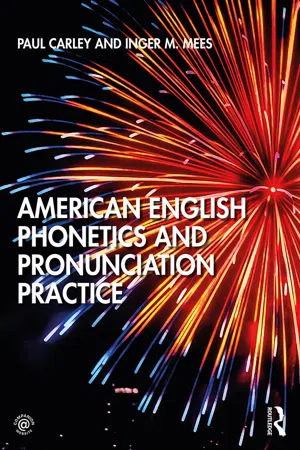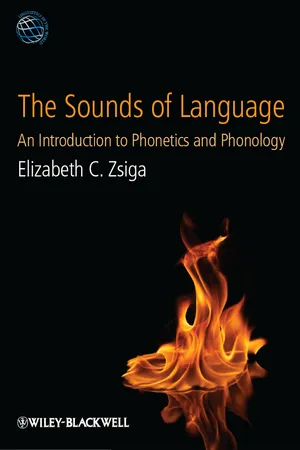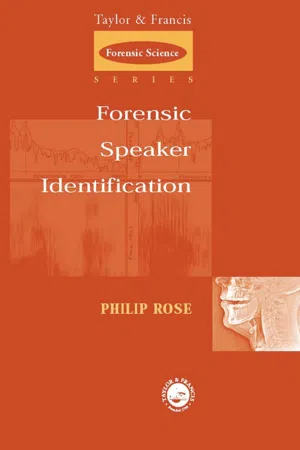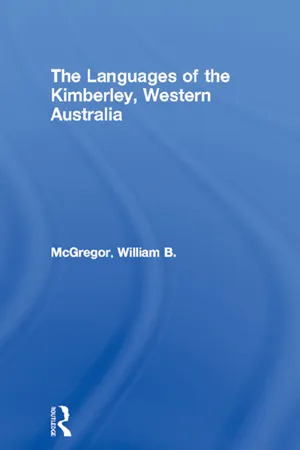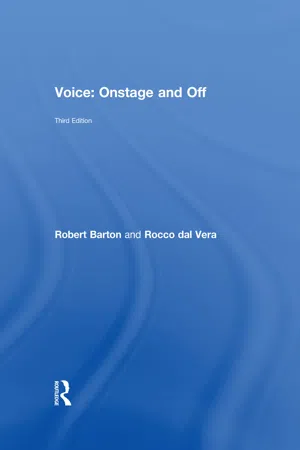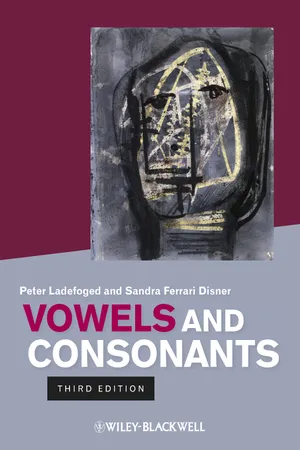Languages & Linguistics
Vowels
Vowels are speech sounds produced without any significant constriction or closure in the vocal tract. They are a fundamental component of all spoken languages and are characterized by the absence of any audible friction or noise. In the International Phonetic Alphabet (IPA), vowels are represented by a distinct set of symbols that indicate their specific articulatory and acoustic properties.
Written by Perlego with AI-assistance
10 Key excerpts on "Vowels"
- eBook - ePub
Phonology in English Language Teaching
An International Approach
- Martha C. Pennington(Author)
- 2014(Publication Date)
- Routledge(Publisher)
3VowelsCharacteristics of VowelsThe nature of Vowels
Vowels can be distinguished definitionally from consonants as having a relatively open aperture of articulation. All Vowels are more open in aperture than all consonants. In general, when we speak of Vowels, we are referring to voiced Vowels. It is possible to produce Vowels in a voiceless way, i.e. without vocal fold vibration, as in whispering a word that contains a vowel. However, since the vowel phonemes of most languages are voiced, voiceless Vowels are considered to be highly marked, and when people speak of Vowels, they generally mean the unmarked, i.e. voiced, type. Therefore, unless explicitly stated otherwise, all references to Vowels below are to voiced Vowels.The class of sonorant sounds, which includes voiced Vowels, nasal consonants and voiced approximants, is opposed to the class of obstruent sounds (stops, fricatives and affricates). Of all the sonorants, Vowels have the greatest sonority. The sonority of a sound is its inherent loudness, or strength. Vowels are inherently louder than consonants because the energy used in producing them escapes out of the vocal tract with relatively little of it being dissipated by obstructions along the way. The perception of loudness is a consequence of the amount of energy which exits the vocal tract and reaches the ear of the listener.The sonority of Vowels makes it easy to prolong them, as in singing. Because Vowels are inherently louder than consonants and can be prolonged, they form the core, or nucleus, of most syllables in most languages. As a consequence of the inherent difference between Vowels and consonants, the two types of segments convey different types of information in speech. In the words of Werker and Polka (1993):As continuants, Vowels are articulated more slowly, have more prominent and long-lasting acoustic cues, and can be used to provide more prosodic information than consonants. Thus Vowels carry information about stress, speaker identity and emotional tone. In comparison, consonants convey less prosodic information, but play a central role in signaling differences in lexical meaning, (p. 89) - Paul Carley, Inger Mees(Authors)
- 2019(Publication Date)
- Routledge(Publisher)
Chapter 5Vowel theory
5.1 Describing VowelsWe saw in Chapter 2 that a consonant is a speech sound that involves an obstruction to the airstream on its way through the vocal tract. So what then is a vowel? A vowel is the opposite of a consonant: a sound made with no obstruction in the vocal tract to the air as it passes through it.Say a long /ɑ/, the sound doctors ask us to make when they want to look into our mouths, and feel how the air flows out through your mouth without any obstruction. Try the same for /i/, the <ee> of tree, and /æ/, the <a> of cat. You will notice that the lips and tongue take different positions for these different Vowels, but in each case, there’s no obstruction or blockage of the kind that we find in consonants.If consonants are analyzed in terms of the kind of obstruction involved and where it is in the vocal tract, how can we analyze Vowels, which have no such obstruction? Although the tongue and lips assume a wide range of complex shapes for the articulation of different Vowels, a relatively simple system has been developed to describe them. Figure 5.1 shows the vowel diagram from the chart of the International Phonetic Association, which is based on this system of vowel description.5.1.1 Tongue shapeIn order to understand the system behind the diagram, the first step is to explore the limits of the range of tongue positions used to make Vowels, known as the vowel space. There are two fixed articulatory reference points to the system. To find the first, you make a vowel with the front of the body of your tongue pushed as far forward and as far up toward the hard palate as possible. This is the position for the [i] vowel (see Figure 5.2 ). If you move your tongue any further forward or up, audible friction would result between the tongue and the hard palate, and the sound would no longer be a vowel. The second reference point is found by doing the opposite – opening your mouth and pulling your tongue as far down and back as possible without causing friction between the root of the tongue and the back wall of the pharynx (see Figure 5.3 ). This is the [ɑ] vowel. A further two positions can be identified by pushing the tongue as far up and back as possible (see Figure 5.4 ), which gives us the [u] vowel, and by pushing the tongue as far forward and down as possible (see Figure 5.5 ), which gives us the [a] vowel. Note that during the production of all these Vowels, the tongue tip and blade (see Figure 5.6- eBook - ePub
- Karen Pollock(Author)
- 2013(Publication Date)
- Psychology Press(Publisher)
vowel as used in this chapter. As we shall see, even providing a simple but unambiguous definition is not straightforward. The problem relates in large part to the difference between phonetic and phonological usages of the term. As many authors have noted, from a phonetic perspective Vowels can be described as resonant segments that are produced with an unobstructed laminar airflow escaping centrally through the vocal tract (Ladefoged, 1993; Laver, 1994; Ashby & Maidment, 2005). In contrast, consonants involve some degree of constriction in the vocal tract, which either blocks the airflow momentarily, causes it to become turbulent, or diverts it from a central oral path. Phonologically, on the other hand, Vowels are viewed from distributional and functional perspectives, and can be described as those segments that may occupy the center or nucleus of a syllable, as opposed to consonants, which occur in marginal positions in a syllable (onsets and codas).Ball and Rahilly (1999: 43) point out that “these two approaches to defining consonants and Vowels overlap in the majority of cases.” But, as they go on to observe, some sounds that appear to match a phonetic description of the category of Vowels (e.g., /j/ and /w/), have patterns of distribution that place them in the consonant category according to a phonological perspective. Catford (1977) provides a long discussion on the ambiguous relationship of approximants and Vowels, noting inter alia that /j/ and /w/ are differentiated phonetically from the high Vowels /i/ and /u/ on durational grounds, and are very similar in terms of articulatory stricture. Also, Stevens (1998) points out that glides have broader formant bandwidths than their corresponding Vowels, due to a slightly greater degree of constriction. Similarly, some sounds we would happily term consonants on the grounds of their phonetic characteristics may occur as syllable nuclei (e.g., [l̩] and [n̩], often termed syllabic consonants). Because of this potential ambiguity, Pike (1947) suggested a two-way categorisation, reserving the terms vowel and consonant to reflect a segment’s phonological behaviour, and using the terms contoid and vocoid to imply phonetic characteristics of segments. In this way, one might distinguish four sets of sounds: contoid consonants (e.g., [p], [s]), vocoid Vowels (e.g., [i], [a]), contoid Vowels (e.g., [l̩], [n̩]), and vocoid consonants (e.g., [j], [w]). In this chapter, we will restrict our use of the term vowel to those segments that comply with both the phonetic and phonological definitions of vowel given above, in other words, to segments described by Pike (1947) as vocoid Vowels. - eBook - ePub
The Sounds of Language
An Introduction to Phonetics and Phonology
- Elizabeth C. Zsiga(Author)
- 2012(Publication Date)
- Wiley-Blackwell(Publisher)
All speech is organized around this repeated closing–opening, consonant–vowel sequence, and all languages make this basic distinction. While it would be theoretically possible, no language is composed of all consonants or all Vowels. Certain words might be all one or the other, like English [ ] or Oowekyala [ ] powder, so one could imagine a whole language made up of such words, but no natural language works that way. The repeated closing–opening sequence forms the basis of syllable structure. The most basic syllable type is CV: a consonantal constriction released into a vowel. Children’s first words tend to be of the form [papa] or [mama], and all languages have syllables of CV shape. (Some, like English, allow syllables that are quite a bit more complicated, but all languages allow at least CV, and some allow only CV.) The Vowels, in a way, form the background against which the consonantal constrictions can be heard. During the closure for a voiceless stop, after all, there is nothing but silence: we only perceive that silence as a consonant because of its contrast with the Vowels around it. A syllable can be defined as a grouping of segments. A more open articulation, usually a vowel, forms the syllable nucleus. More constricted consonantal articulations associated to the nucleus constitute the preceding onset and following coda. In the syllable [læf], [æ] is the nucleus, [l] is the onset, and [f] is the coda. Sometimes the more open articulation can be another consonant, as in Czech [ ] wolf ; or the “opening” can occur through the nasal passages, as in English “prism” [ ]. In these cases, the less constricted consonant forms the syllable nucleus. These are termed syllabic consonants, and their status as a syllable nucleus is indicated by a vertical line beneath the symbol. Syllables, in turn, often alternate between more prominent and less prominent, or stronger and weaker - eBook - ePub
- Phil Rose(Author)
- 2002(Publication Date)
- CRC Press(Publisher)
manner of articulation).Vowels are produced by modifying the shape of the supralaryngeal vocal tract in non-radical ways. By primarily moving the tongue body and changing the lip aperture, the vocal tract is effectively squeezed at differing locations along its length, creating vocalic resonators of different dimensions. By lowering the soft palate an additional set of nasalised Vowels can be produced, and Vowels can also be produced both long and short. More than one vocalic target can be produced in a syllable, giving rise to diphthongs and triphthongs. These modifications can be described phonetically in terms of the vowel’s height, backness, rounding, nasalisation, length and dynamicity. Speech sounds are analysable and describable in terms of smaller components called features.Suprasegmentals: Stress, intonation, tone and pitch accent
In the previous sections, the production of Vowels and consonants was described. These sounds are referred to as segmental, the metaphor being that they are strung together like segments in a word. A second major class of speech sounds – that containing intonation, stress, and tone – is called suprasegmental, the inference being that they in some sense exist on top of the segmental sounds. This inference is somewhat misleading because intonation, stress, and tone are mostly associated with laryngeal activity, which, if you are speaking standing up, even in Australia, takes place below the other speech-producing organs.Stress has to do with the relative prominence of syllables within a word. Tone has to do with the use of different pitch shapes to signal word identity, and intonation has to do with the use of pitch to signal features of utterances longer than the word. These, together with another suprasegmental category called pitch accent, will be discussed and exemplified below. - eBook - ePub
- Bruce M. Rowe, Diane P. Levine(Authors)
- 2022(Publication Date)
- Routledge(Publisher)
The articulation of Vowels is more difficult to describe because, unlike consonants, Vowels involve no obstruction of the airstream. Therefore, it is more difficult to tell what configurations the speech organs are in when producing Vowels. The vibration of the air caused by the vibration of the vocal folds, along with the factors listed below, creates the vowel sounds. Because a main mechanism of vowel production for most vowel sounds is vibrating vocal folds, most Vowels are voiced. Voiceless Vowels do occur in English but only under special circumstances. Some languages have voiceless Vowels as a regular part of their sound systems.The other factors involved in vowel production are- which resonance chamber is used – the oral cavity, or both the oral and nasal cavities.
- the shape of the resonance chamber, which is affected by tongue height, tongue advancement (front to back), and lip rounding or spreading.
The oral and nasal cavities
We can divide Vowels into oral Vowels and nasalized Vowels. Oral Vowels occur when the velum is raised, cutting off the entry of the airstream into the nasal cavity. Nasalized Vowels are created when the velum lowers, permitting the airstream to flow through both the oral and nasal cavities. In English, Vowels are almost always oral. However, nasalization of Vowels occurs before nasal consonants. Can you hear the difference in the vowel sound (phonetically symbolized as [æ]) in hat [hæt] and ham [hæ̃m]? The [æ̃] in ham employs the nasal cavity in its production. Can you hear this contrast in the Vowels in seat [sit] and seam [sim]? The diacritic mark [˜] I indicates nasalization.Vowels and the shape of the resonance cavity
Figure 2.3 - William B. McGregor(Author)
- 2013(Publication Date)
- Routledge(Publisher)
4 PHONETICS AND PHONOLOGY4.1 Types of soundsIn all human languages most speech sounds are produced by pushing air out of the lungs, through the GLOTTIS or voice box, and then through either the mouth or the nose. The glottis contains the vocal cords or folds, which if held together not too tightly as the air passes through them, will vibrate, giving rise to voicing. These vibrations can be felt by holding your Adam’s apple between your thumb and first finger, and making the sounds mm and aa. Speech sounds that are accompanied by voicing are said to be VOICED ; all others are VOICELESS . The mouth and nose cavities also have an important role: by modifying the stream of air passing through in various ways, production of a range of different sounds is possible.The sounds of human languages fall into two main groups: CONSONANTS and Vowels . Consonants are made with a noticeable obstruction of the airstream between the glottis and the outside air. For Vowels, by contrast, the air passes unimpeded through the mouth. Compare, for instance, the two sounds in the English word fee. The first, the consonant f, is made with the upper teeth touching the bottom lip, while air is forced through this narrow opening, thereby producing audible friction. The second, the vowel written ee, does not involve obstruction anywhere in the mouth, and the sound comes out ‘purely’. You will also notice that the vocal cords are vibrating for the vowel ee, but not for the consonant f. Vowels are normally voiced.Consonants are classified according to the MANNER by which they are produced, and the PLACE- eBook - ePub
Linguistics for Language Teachers
Lessons for Classroom Practice
- Sunny Park-Johnson, Sarah J. Shin(Authors)
- 2020(Publication Date)
- Routledge(Publisher)
pitch. Improving pronunciation in a second language requires learning not only the features of individual consonants and Vowels but also the suprasegmental features that extend across multiple segments in an utterance.2.8.1 Length
The first suprasegmental feature we will consider is length. In many languages, differences in the duration of segments can be meaningful. For example, Japanese contrasts between short and long Vowels in words like [ojisan] “uncle” and [oji:san] “grandfather”, as well as [obasan] “aunt” and [oba:san] “grandmother”. The colon [:] placed after a vowel indicates that it is lengthened. In Thai, vowel duration is linked to differences in meaning in words such as [tak] “to dip up” versus [ta:k] “to dry”, and [khut] “to dig” versus [khu:t] “to scrape”. Some languages contrast short and long consonants. In Arabic, consonant lengthening results in meaning difference in [qabala] “he accepted” versus [qabbala] “he kissed”. In Finnish, [kuka] means “who” while [kukka] means “flower”. The doubled consonant in these examples reflects lengthening.2.8.2 Stress
Consonants and Vowels together form syllables, which make up utterances. In any utterance, some syllables are perceived to be more prominent than others and are said to have greater stress. Stressed syllables are generally longer, louder, and higher in pitch than unstressed syllables. In English, stress can have a grammatical function. For example, variations in stress are used to distinguish between a noun and a verb in English. When you say the words (an) ínsert versus (to) insért, (a) cóntrast versus (to) contrást, or (a) présent versus (to) presént, you will notice that the stress is on the first syllable in the nouns whereas it is on the last syllable in the verbs. Stress can also be used to emphasize certain words in expressions like She’s wearing a pínk dress (not a blue dress), as opposed to She’s wearing a pink dréss (not a suit) - eBook - ePub
- Robert Barton, Rocco dal Vera(Authors)
- 2017(Publication Date)
- Routledge(Publisher)
Actors can sometimes get intimidated when asked to learn phonetics, but it is easy! In order to transcribe English, you have to learn no more than twenty-two symbols altogether, which is not much of an investment for a tool you can use for the rest of your life. Many symbols have the same function as the normal letters of our alphabet: b, d, f, g, h, k, l, m, n, p, r, s, t, v, w, z. Those are sixteen of the twenty-four consonant sounds of English. There are only eight other consonants to learn. But first, when we say Vowels and consonants, what do we mean?UNIT 3.4 Sound groups
Two broad groups of sounds make up speech: Vowels (produced without any obstruction or blockage), and consonants (made using various forms of inhibition). It’s that simple.EXERCISE 3.4.1 SEPARATING Vowels FROM CONSONANTS- Say aaah [ɑ]. Nothing stops or inhibits the flow of air and sound. That is what defines a vowel: no obstruction. Now make the sound vvvv [v].The pressure of your lower lip against your upper teeth inhibits the flow of air and creates a buzzing consonant sound. If you say them close together [ɑ v], you can feel the open vowel sound close off into the consonant.
- Reverse the process by making the sound zzzz [z] followed by eeee [i]. Here you can feel the constricted consonant open into the vowel [z i].
As you learn to transcribe using phonetics, remember that phonetic symbols aren’t letters. They are representations of sounds, and sounds are produced by the body through complex gestures: [b] for example, involves air being expelled from the lungs past vibrating vocal folds, the air being stopped by closed lips, and then being explosively released. We use the glyph [b] to encapsulate all that articulatory information.When we talk about consonants, the way we describe them is articulatory because looking at what the body does provides a common reference. When we talk about Vowels, we can describe them as physical behaviors too, but the way we hear Vowels is a more important key to distinguishing them. For example, the difference between the words heed and hid - eBook - ePub
- Peter Ladefoged, Sandra Ferrari Disner(Authors)
- 2012(Publication Date)
- Wiley-Blackwell(Publisher)
The members of the group of sounds forming a phoneme always occur in different places – before a vowel, between Vowels, before n, or in some other phonetic context. The distinctive sounds – the phonemes – of a language can theoretically be described in terms of a universal set of features that applies to all languages. But nobody can give a full account of this set of features because languages are, and always have been, constantly changing. Who knows what the future may bring?
Index pages curate the most relevant extracts from our library of academic textbooks. They’ve been created using an in-house natural language model (NLM), each adding context and meaning to key research topics.
Explore more topic indexes
Explore more topic indexes
1 of 6
Explore more topic indexes
1 of 4

